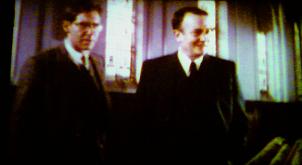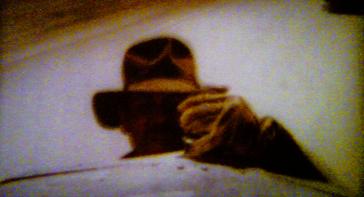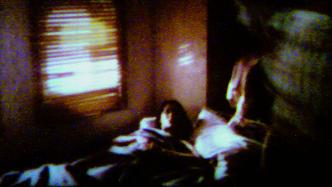|
Author
|
Topic: And my AGFA print also get faded now... : -(
|
Winbert Hutahaean
Film God
Posts: 5468
From: Nouméa, New Caledonia
Registered: Jun 2003
|
 posted August 25, 2008 01:04 AM
posted August 25, 2008 01:04 AM



Guys,
There many members here are very sure that AGFA print will always hold the color forever.
But my experience does show the opposite and it should be learnt that AGFA print can also fade.
My find was started after seeing that all my Universal 8 (on Kodak SP and Eastman) have faded to nice red wine color, so I looked for my lovely AGFA print that I believe many members this forum have it.
It is "Raiders of the lost ark" (1 x 400", Marketing Films).
I still remember first time I received this film in Sydney in 1997 and I got surprised with the colors which were so beautiful. That's why I made a note on the box that it has "Excellent" color.
I played it many times until 2003 and still found the beauty of its colors (ps: actually it's faded a little but be assured by many mails that AGFA would not fade, I still felt that it was "Excellent").
But after 2003 I didn't see this film and just took it last nigh and the result was: it has faded... not red, not pink but some colors have gone. You can see from my pictures below:

Please note that my auto digital camera did an automatic color correction on below pictures so it looks now fine for us, but actually it was warmer than this.


The fade of my film is much clearer on the below 3 pictures because the scene was outside and brighter.



and when it came to a darker scene, fade was more horrifying !!

So to sum up, AGFA and (perhaps) Fuji from that era can also fade, DEPEND ON where you live.
I live in Indonesia where the climate is tropical (28-32 Celsius)and humidity is high (80-95%). I cannot have a speial cold storage for the films (like Osi does), so I store them on a wood shelf. And they got faded, eventually.
This come to a conclusion for those who live in (or buy films from) Queensland (Aus), Darwin (Aus), Perth (Aus), Indonesia and south East Asian countries, Latin American countries, California (??) will most highly get faded films.
You guys, live in UK are so lucky due to your cool climate and low humidity. that is why the fading process is so slow. But eventually it will.
I don't know what will happen to the latest LPP print. I have a couple from Derann, and have to wait until another 4-5 years.
We'll see.
cheers,
--------------------
Winbert
| IP: Logged
|
|
|
|
Osi Osgood
Film God

Posts: 10204
From: Mountian Home, ID.
Registered: Jul 2005
|
 posted August 25, 2008 09:43 AM
posted August 25, 2008 09:43 AM




Winbert,
Just for hobbies sake, I looked at my "Raiders 400ft" and, like Kevin's, the colours are smashing, but as you said, yours have obvious fade. Very sad.
--------------------
"All these moments will be lost in time, just like ... tears, in the rain. "
| IP: Logged
|
|
|
|
|
|
|
|
|
|
Osi Osgood
Film God

Posts: 10204
From: Mountian Home, ID.
Registered: Jul 2005
|
 posted August 27, 2008 10:06 AM
posted August 27, 2008 10:06 AM




Ya see folks,
Now there's a person who knows how to love his films, (not that we all don't tend to do our best)!
But then, I really don't think any of us are really to blame. After all, back in the heyday of Super 8, there was no fade, (that I know of) It really didn't become an issue until, when? The late eighties or early 90's?
--------------------
"All these moments will be lost in time, just like ... tears, in the rain. "
| IP: Logged
|
|
|
|
|
|
Osi Osgood
Film God

Posts: 10204
From: Mountian Home, ID.
Registered: Jul 2005
|
 posted August 28, 2008 09:51 AM
posted August 28, 2008 09:51 AM




You know, hearing about all these old color film processes, (Gevacolor, Kodachrome), makes me wonder if, when Eastman color first came out, that it was more for the sake of cost cutting that it came about. I'm betting the old color formats that hold up so well, (Cinecolor, for instance, which STILL, after 70 years, looks great), were also more expensive to process and manufacture ...
... but you just can't "fudge" on quality. Sometimes high quality is that way because of the cost that goes into it.
A lot of the cartoon studio's (Warners included) to save on thier budgets, used lower cost forms of color, and even when those cartoons are restored, the color palette is still muted compared to original Technicolor processed color.
In a documentary entitled, "Glorious Technicolor" (I'm sure some of you have seen it), a studio photographer was first working with Eastman color, and he noticed that the womens lips had the color of liver. He then took various shades of lipstick to see if he could correct the problem, and upon inspecting the newly shot and processed Eastman color stock, the lips were still turning out various aspects of "liver".
Winbert does have a great point about AGFA. I believe that those who manufactured the original bad fade eastman, even for the Hollywood studio's, knew of it's fade possibilities, but it was so cost saving, that Hollywood moguls, who were desperate to cut costs wherever they could, (especially in the fifties and sixties, when they were having problems), were willing to toss a blind eye to the eastman problem ...
... after all, back then, you could perhaps liscense your feature film to TV here and there, and perhaps re-release a great film from the past in theaters once again, but no one had any idea that they could release thier vast catalog on VHS, Laserdisc, DVD and now Blu-ray!
Just like with the logic that no doubt went into the optical sound Super 8, (short run on the airlines, then destroy the prints), they felt that the prints would only be needed for a short shelf life.
... and this brings me back to Winberts point ...
I do wonder that, even with the "expected" Lifetime of viewing enjoyment with L.P.P. or AGFA, perhaps those developers of these film stocks in the first place, know something that we don't? Perhaps our mighty AGFA stock will disinigrate a lot earlier than we would have hoped?
It is a worrysome thought.
I do believe that, with the proper storage, even the worst film stocks will hold up rather well, but it takes dedication on our parts, becoming the unknown film preservationists for a future generation, so that our grand children or perhaps great grand children, who have been no doubt brought up with "Holographic projection" reality like movies of the future, will have a very rare glimpse at what film-making and enjoyment once was!
--------------------
"All these moments will be lost in time, just like ... tears, in the rain. "
| IP: Logged
|
|
|
|
Paul Adsett
Film God
Posts: 5003
From: USA
Registered: Jun 2003
|
 posted August 28, 2008 11:40 AM
posted August 28, 2008 11:40 AM



Hi Osi,
I also have the 'Glorious Technicolor' feature, which is on the 2-disc DVD issue of 'Robin Hood'. A fascinating documentary indeed, which showed that Technicolor was really a miraculous process. Herbert Kalmus was a genius. Expensive as hell, but nothing else ever came close, Technicolor reigns supreme. Just look at the pale washed-out color of today's feature films.
--------------------
The best of all worlds- 8mm, super 8mm, 9.5mm, and HD Digital Projection,
Elmo GS1200 f1.0 2-blade
Eumig S938 Stereo f1.0 Ektar
Panasonic PT-AE4000U digital pj
| IP: Logged
|
|
Osi Osgood
Film God

Posts: 10204
From: Mountian Home, ID.
Registered: Jul 2005
|
 posted August 28, 2008 01:47 PM
posted August 28, 2008 01:47 PM




I agree Paul, though sometimes the pale washed out look of todays film can by stylistic, (as in the case of "Minority Report" or "Saving Private Ryan", both Speilberg films that were very influential in the look of a lot of films today.
You know, the strange thing about Technicolor, is that I always felt that technicolor looked "ultra real", in that it was almost TOO colorful. Real life looked pale compared to a technicolor film.
--------------------
"All these moments will be lost in time, just like ... tears, in the rain. "
| IP: Logged
|
|
|
|
|
|
|
|
|
|
|
|
|
|
Paul Adsett
Film God
Posts: 5003
From: USA
Registered: Jun 2003
|
 posted August 29, 2008 07:14 PM
posted August 29, 2008 07:14 PM



Which raises the question as to why Kodak abandoned their very best ever product - Kodachrome? Did it all come down to cost?
Incidentally, I can understand the process of black and white photography but color photography, in any form, is miraculous to me. And the Technicolor process, where relief images are formed for the reception of cyan, magenta, and yellow dyes, just blows my mind. ![[Eek!]](eek.gif)
--------------------
The best of all worlds- 8mm, super 8mm, 9.5mm, and HD Digital Projection,
Elmo GS1200 f1.0 2-blade
Eumig S938 Stereo f1.0 Ektar
Panasonic PT-AE4000U digital pj
| IP: Logged
|
|
David Kilderry
Jedi Master Film Handler

Posts: 963
From: Melbourne, Victoria, Australia
Registered: Feb 2006
|
 posted August 29, 2008 09:14 PM
posted August 29, 2008 09:14 PM




Paul, yes my contacts at Kodak told me the cost of the building in Switzerland that housed the complicated Kodachrome processing plant, and was intregal to the building, was the main reason. It could not be moved or rebuilt economically.
All the other film based products that were housed originally in the same building were closed or moved as sales diminished. They did not want to cease Kodachrome in a perfect world.
They did not abandon Super 8, as witnessed by the 64t release, as believe it or not even in this day there is still profit in all of their motion picture formats: Super 8, 16mm, 35mm and 65/70mm for 15/70 IMAX.
I understand that LPP has a 99 year no fade life, but I have not seen this advertised and as Kevin states, Kodachrome is regarded as archival, yet not LPP. I may have the chance to speak with senior Kodak Rochester head office people at a conference I am attending next week.
David
| IP: Logged
|
|
|
|
|
|
|
|
|



 UBBFriend: Email this page to someone!
UBBFriend: Email this page to someone!
 Printer-friendly view of this topic
Printer-friendly view of this topic













![[Mad]](mad.gif) but
but ![[Big Grin]](biggrin.gif)


![[Eek!]](eek.gif) A market leader
A market leader ![[Frown]](frown.gif)




